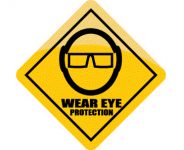Category: Personal Protective Equipment
No safety technology is changing as fast as that employed in PPE. The devices of just a few years ago are now obsolete by replacements that are lighter, easier to use, and more protective. These resources alert you to developments in the field, and equally important, supply training ideas to get your workers to use their PPE, and use it correctly.
Free Special Report: Does Your PPE Program Meet OSHA’s Requirements?
How many jobs in your facility could be performed by someone wearing a blindfold? Even a relatively minor eye injury can send a worker home for the day, so it makes not only safety sense but also business sense to protect workers’ eyes. March is Workplace Eye Health and Safety Month, which makes this an […]
When a worker gets hazardous substances in the eyes or on the skin, seconds count. Make sure your workers can get to an eyewash station or safety shower quickly and know how to use it properly. A worker mixes chemicals incorrectly, and they explode in his face. Another drops a bottle, and the chemical splashes […]
Falls are a leading cause of workplace injury and death. Fall protection also routinely makes OSHA’s Top 10 Violations list every year. Employees fall for many reasons: unstable working surfaces, improperly positioned ladders, misuse of fall protection, and unprotected sides and edges of working surfaces. OSHA says that you must set up your worksite to […]
Despite the significant risk of injury or death, construction workers continue to work at heights without fall protection. A recently published study examines the reasons for this and offers solutions that could prevent an accident or save a life. The researchers/authors of Fall Protection in Residential Construction Sites, which appeared in the July issue of […]
OSHA requires a thorough hazard assessment before PPE is selected and assigned to employees. Find out more. If you were a NFL coach, you wouldn’t send your team out on the field without helmets and shoulder pads. If you were a NASA manager, you wouldn’t send an astronaut for a space walk without a space […]
Honeywell, which manufactures PPE, fire alarm systems, and other products, has opened a $3 million facility to demonstrate their safety products and systems and train people to use them. Honeywell Life Safety President Mark Levy says the company chose Houston for its new safety product showcase because of its concentration of global oil and gas, […]
Most of us have encountered a deal that was too good to be true. Could your approach to workplace safety and PPE also be too good to be true? Take a look at these “simple solutions” to workplace hazards, and consider whether you may need to look a little more closely. Disposable Foam Earplugs. If […]
When workers make mistakes with PPE, the consequences can be grim. In the health and safety professional’s “hierarchy of controls,” PPE falls in last place—behind engineering controls and work practice or administrative controls. The reasoning is that engineering controls address the hazard directly, and have the fewest potential failure points, so they are most protective. […]
HAZWOPER rules (29 CFR 1910.120 Appendix B) delineate four levels of PPE required to protect workers under various site conditions. Here’s what you need to know. Level A Should be worn when the highest level of respiratory, skin, and eye protection is needed (i.e., for use with highly toxic releases, such as chlorine or ammonia). […]
Here’s a simple four-step plan to improve PPE deployment in your workplace and help ensure that employees always use the right PPE for the hazards they face. 1. Assess. Section 1910.132(d)(1) of the OSHA standard says that employers must “assess the workplace to determine if hazards are present, or are likely to be present, which […]



